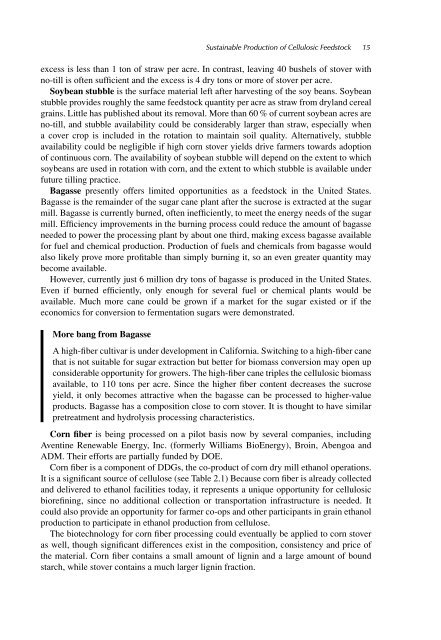Biofuels in Perspective
Biofuels in Perspective
Biofuels in Perspective
Create successful ePaper yourself
Turn your PDF publications into a flip-book with our unique Google optimized e-Paper software.
Susta<strong>in</strong>able Production of Cellulosic Feedstock 15<br />
excess is less than 1 ton of straw per acre. In contrast, leav<strong>in</strong>g 40 bushels of stover with<br />
no-till is often sufficient and the excess is 4 dry tons or more of stover per acre.<br />
Soybean stubble is the surface material left after harvest<strong>in</strong>g of the soy beans. Soybean<br />
stubble provides roughly the same feedstock quantity per acre as straw from dryland cereal<br />
gra<strong>in</strong>s. Little has published about its removal. More than 60 % of current soybean acres are<br />
no-till, and stubble availability could be considerably larger than straw, especially when<br />
a cover crop is <strong>in</strong>cluded <strong>in</strong> the rotation to ma<strong>in</strong>ta<strong>in</strong> soil quality. Alternatively, stubble<br />
availability could be negligible if high corn stover yields drive farmers towards adoption<br />
of cont<strong>in</strong>uous corn. The availability of soybean stubble will depend on the extent to which<br />
soybeans are used <strong>in</strong> rotation with corn, and the extent to which stubble is available under<br />
future till<strong>in</strong>g practice.<br />
Bagasse presently offers limited opportunities as a feedstock <strong>in</strong> the United States.<br />
Bagasse is the rema<strong>in</strong>der of the sugar cane plant after the sucrose is extracted at the sugar<br />
mill. Bagasse is currently burned, often <strong>in</strong>efficiently, to meet the energy needs of the sugar<br />
mill. Efficiency improvements <strong>in</strong> the burn<strong>in</strong>g process could reduce the amount of bagasse<br />
needed to power the process<strong>in</strong>g plant by about one third, mak<strong>in</strong>g excess bagasse available<br />
for fuel and chemical production. Production of fuels and chemicals from bagasse would<br />
also likely prove more profitable than simply burn<strong>in</strong>g it, so an even greater quantity may<br />
become available.<br />
However, currently just 6 million dry tons of bagasse is produced <strong>in</strong> the United States.<br />
Even if burned efficiently, only enough for several fuel or chemical plants would be<br />
available. Much more cane could be grown if a market for the sugar existed or if the<br />
economics for conversion to fermentation sugars were demonstrated.<br />
More bang from Bagasse<br />
A high-fiber cultivar is under development <strong>in</strong> California. Switch<strong>in</strong>g to a high-fiber cane<br />
that is not suitable for sugar extraction but better for biomass conversion may open up<br />
considerable opportunity for growers. The high-fiber cane triples the cellulosic biomass<br />
available, to 110 tons per acre. S<strong>in</strong>ce the higher fiber content decreases the sucrose<br />
yield, it only becomes attractive when the bagasse can be processed to higher-value<br />
products. Bagasse has a composition close to corn stover. It is thought to have similar<br />
pretreatment and hydrolysis process<strong>in</strong>g characteristics.<br />
Corn fiber is be<strong>in</strong>g processed on a pilot basis now by several companies, <strong>in</strong>clud<strong>in</strong>g<br />
Avent<strong>in</strong>e Renewable Energy, Inc. (formerly Williams BioEnergy), Bro<strong>in</strong>, Abengoa and<br />
ADM. Their efforts are partially funded by DOE.<br />
Corn fiber is a component of DDGs, the co-product of corn dry mill ethanol operations.<br />
It is a significant source of cellulose (see Table 2.1) Because corn fiber is already collected<br />
and delivered to ethanol facilities today, it represents a unique opportunity for cellulosic<br />
bioref<strong>in</strong><strong>in</strong>g, s<strong>in</strong>ce no additional collection or transportation <strong>in</strong>frastructure is needed. It<br />
could also provide an opportunity for farmer co-ops and other participants <strong>in</strong> gra<strong>in</strong> ethanol<br />
production to participate <strong>in</strong> ethanol production from cellulose.<br />
The biotechnology for corn fiber process<strong>in</strong>g could eventually be applied to corn stover<br />
as well, though significant differences exist <strong>in</strong> the composition, consistency and price of<br />
the material. Corn fiber conta<strong>in</strong>s a small amount of lign<strong>in</strong> and a large amount of bound<br />
starch, while stover conta<strong>in</strong>s a much larger lign<strong>in</strong> fraction.








